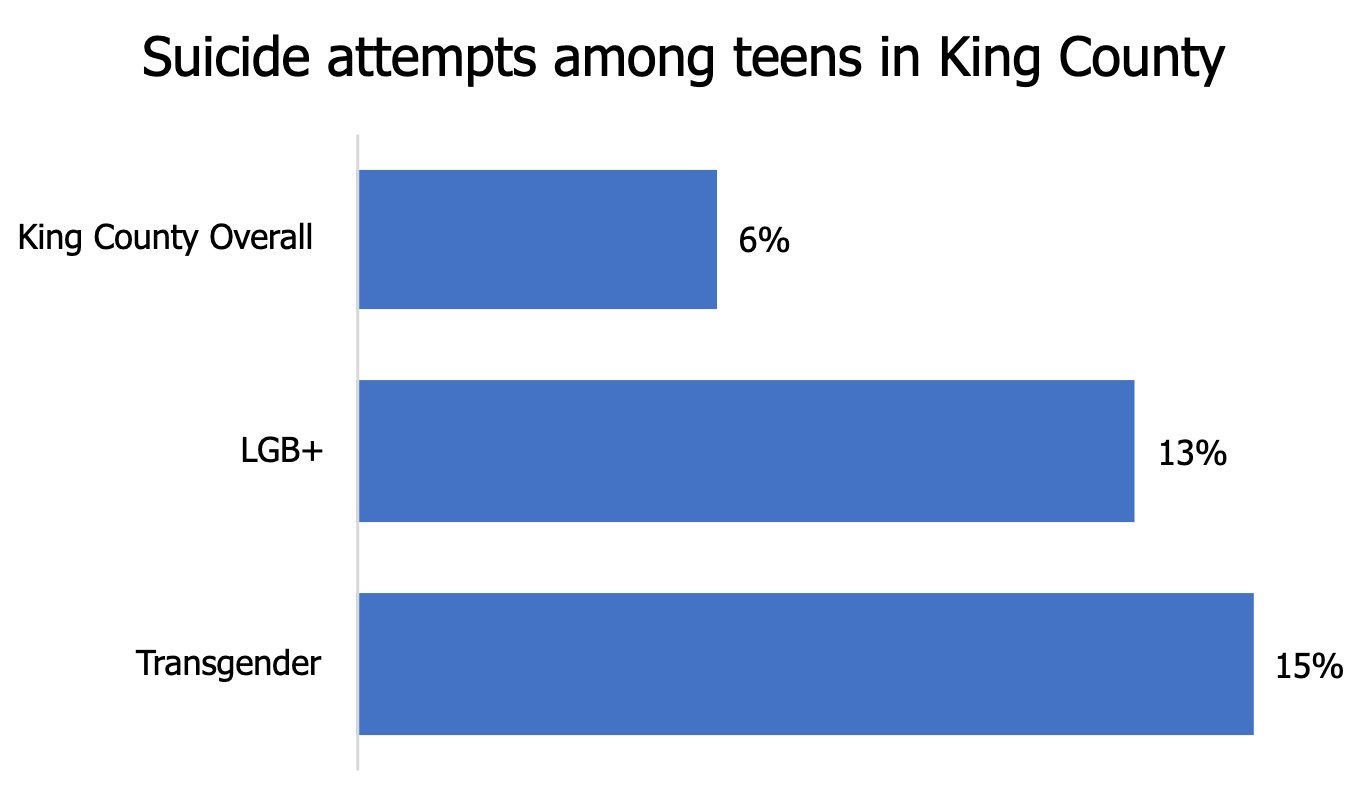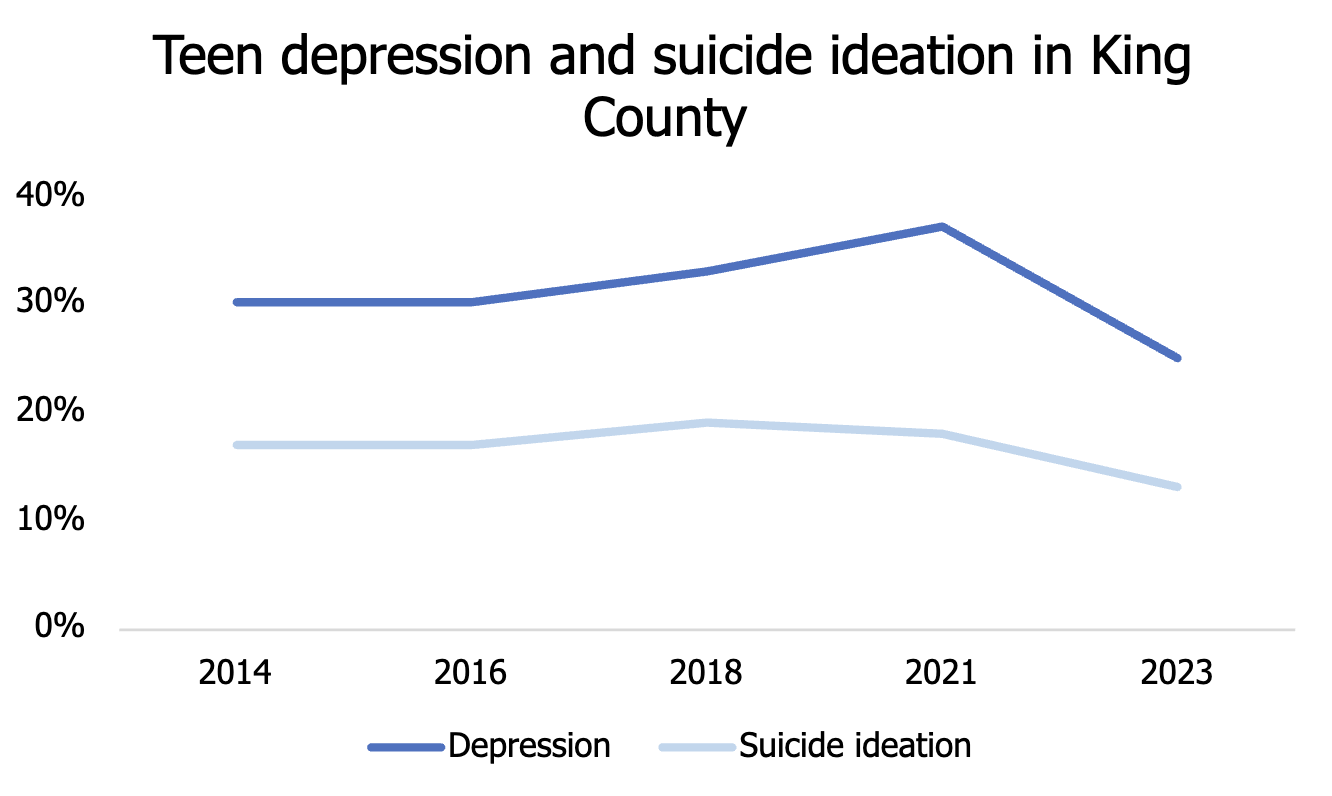From Data to Action: Addressing Youth Mental Health and Substance Use in King County
Youth wellbeing is a priority, and we’re excited to share the recent release of the Youth Mental Health and Substance Use in King County data brief. This brief brings together local data from multiple sources and amplifies youth voices to highlight the continuum of supports needed. Developed in collaboration with multiple departments in King County and Seattle Children’s, it underscores the importance of ensuring that all youth have access to culturally responsive and developmentally appropriate mental health resources.
Understanding the Need: A Continuum of Support
Young people in King County, like those everywhere, need spaces and opportunities to develop their strengths, build relationships, and receive the support they need as they navigate challenges. However, many youth—particularly those who are Black, Indigenous, or People of Color (BIPOC) and those who identify as LGBTQ2S+—face additional barriers due to systemic inequities and discrimination.
Rather than focusing on isolated areas of intervention, it is crucial to invest in a comprehensive, continuum-based approach. From positive promotion of mental health to crisis intervention and long-term recovery, King County’s local data sheds light on key areas where action is needed to ensure youth well-being.
Continuum of Support for Young People's Well-being
Investing in Promotion and Prevention
Mental health promotion focuses on creating environments that support resilience and identity development. However, currently, only one in three children in 5th grade or younger live in families where caregivers report strong social support networks. Youth of color have even less access to these critical social support systems. Among teens, 7 in 10 have a supportive adult in their lives, and disparities exist for youth of color.
Prevention efforts highlight the need for accessible, stigma-free information on mental health and substance use. As one Youth Mental Health Café participant expressed,
“We want more accessible and less intensive resources available to us, to make it seem less scary or less intense.”
Encouragingly, most teens in King County abstain from substance use (86% report not using alcohol, cannabis, or other drugs in the past month). Many report having coping mechanisms such as listening to music or spending time with loved ones. Programs like School-Based Screening, Brief Intervention, and Referral to Treatment (SB-SBIRT), which served over 14,000 students in the 2023-2024 school year, are vital in reinforcing these strengths and ensuring that youth can access the right level of support when they need it.
SB-SBIRT (2023-2024 school year):
2,931 high schoolers participated in screening
56% of students who were screened had a brief intervention
60% of those who had a brief intervention received a referral to additional resources
Crisis Response: Expanding Immediate Support
Without adequate crisis services, young people are at heightened risk for severe outcomes such as overdose and suicide. In 2023, King County Emergency Medical Services responded to 868 non-fatal opioid overdoses among youth aged 11-24, with 15% occurring in those under 18. There were also 53 fatal overdoses in this age group, primarily driven by fentanyl.
Suicide remains a significant concern, with 6% of teens reporting an attempt in the past year as shown below in the bar chart. LGBTQ+ youth face even greater risks, with 13% of LGB+ teens and 15% of transgender teens reporting a suicide attempt. Programs like the Children’s Crisis Outreach Response System, which engaged over 840 youth in crisis in 2023, are critical in providing immediate intervention and ongoing support.
Healthy Youth Survey, 2023. Public Health – Seattle & King County. https://kingcounty.gov/en/dept/dph/about-king-county/about-public-health/data-reports/population-health-data/community-healthindicators/healthy-youth-survey?shortname=Suicide%20attempts
Supporting Recovery and Long-Term Healing
Young people in King County are resilient, but they need sustainable recovery resources. Programs such as Recovery High Schools and Alternative Peer Groups create pathways for youth to regain stability and continue their education. While only 1 in 4 youth in publicly funded substance use treatment in Washington State graduate high school, the Seattle Public Schools Interagency Recovery Campus sees significantly better outcomes, with 63% of students earning or working toward graduation. As one Seattle Public Schools Interagency Recovery Campus student shared,
“The Recovery Campus gave me a place to fit in and find comfort in a sober lifestyle that not many people my age were doing. It gave me an environment where my ideas were valued, and my problems met with solutions rather than dismissal.”
Among teens, depression and suicide ideation rates have begun to decline from their highest levels, as shown below in the line graph below, yet they remain elevated as young people continue to face challenging environments. This further emphasizes that supporting young people is multifaceted and should be viewed as a continuum of support.
These programs not only provide academic support but also foster a sense of belonging and empowerment that is critical to long-term recovery.
Healthy Youth Survey, 2023. Public Health – Seattle & King County. https://kingcounty.gov/en/dept/dph/about-king-county/about-public-health/data-reports/population-health-data/community-healthindicators/healthy-youth-survey
Moving Forward: Turning Data into Action
The data is clear—youth in King County need comprehensive, equitable, and responsive support across the entire continuum of mental health and substance use services. By investing in promotion, prevention, early intervention, treatment, crisis response, and recovery, we can create a system that meets young people where they are and ensures they have the opportunities and resources to thrive.
Everyone involved in supporting young people—families, educators, policymakers, and community organizations—has a role to play in translating these findings into meaningful action. By centering youth voices, addressing systemic inequities, and ensuring sustained investment in effective programs, we can build a future where all young people in King County can grow, heal, and succeed.
Read the full brief for more details in English and Spanish.



